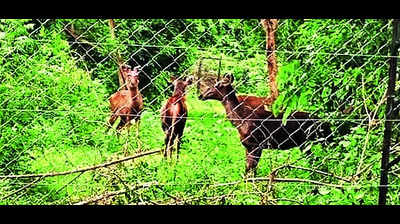
Bhubaneswar: Around 1,500 prey animals have been translocated to different forests and sanctuaries from overcrowded zoos under prey augmentation or recovery programme in the past one year, wildlife officials said here on Monday. Prey augmentation or recovery in sanctuaries that have low prey base (density) is meant to increase population through natural breeding. “In the process, overcrowded zoos are decongested.
Increasing prey density is a priority that will help sustain dispersing carnivores in the long run,” wildlife officials said. Principal chief conservator of forests (wildlife) Susanta Nanda said in Satkosia Tiger Reserve increasing prey density by introducing deer and sambar was necessary, particularly in view of National Tiger Conservation Authority (NTCA) approving resumption of tiger translocation . “We have successfully carried out translocation at Chandaka wildlife sanctuary.

More than 300 ungulates were released into the Chandaka after their quarantine period in the enclosure got over. In Debrigarh, we recently released more than 100 deer and sambar. Their population will increase very fast.
Debrigarh is also slated to receive three Royal Bengal Tigers as part of tiger translocation. So, while Sambalpur zoo was free from congestion, Debriagarh’s prey base received a boost,” Nanda told TOI. Other forests, which witnessed prey augmentation this year are Lakhari wildlife sanctuary, which brought 200 surplus (more than carrying capacity) deer from Taptapani zoo.
Kuldhia wildlife sanctuary in Balasore district released 200 deer brought from Balasore zoo. In Balukhand, 10 blackbuck had been released for recovery of their population. They started breeding.
Twenty more blackbucks will be released soon.Altogether 200 deer were released into Kapilash sanctuary in Dhenkanal district. The zoo of Nalco in Angul is now vacant with all deer released in the sanctuary.
Nanda said Harishankar zoo in Balangir district will be decongested and deer from there will be released into Baisipali wildlife sanctuary while deer from Papadahandi will be released in Karlapat wildlife sanctuary and that of Kuanria zoo in Dasapalla to be released in Mahanadi wildlife division. We also published the following articles recently Eat, prey, love: Number of leopards up 50% in a year at south Delhi's Asola-Bhatti Wildlife Sanctuary The Asola-Bhatti Wildlife Sanctuary in south Delhi has witnessed a significant 50% rise in its leopard population over the past year, now home to 12 leopards including cubs. The increase is due to successful births and the adaptation of a rescued male leopard.
Officials aim to develop a new action plan to address human-animal conflicts. UP forest dept to establish permanent cadre of wildlife vets The UP forest department is taking steps to establish a permanent cadre of veterinary officers for tiger reserves, wildlife sanctuaries, zoos, and lion safaris. This aims to resolve the veterinarian shortage and improve wildlife care.
The plan involves recruiting 30 veterinary officers and providing specialized training at the Wildlife Institute of India. 43cr okayed for Gir sanctuary roads upgrade The state government has sanctioned Rs 43.50 crore for upgrading the Junagadh-Khadiya-Menderada-Sasan Road and Talala-Sasan Road.
This development aims to make travel easier for tourists visiting Gir sanctuary and Devaliya Park, while also improving connectivity to Somnath temple. The upgradation of the 42km stretch will be prioritized..










